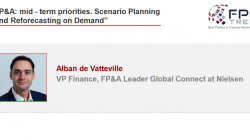FP&A and finance need to have a set of scenarios to support the decision-making process. This is especially important in
High uncertainty was the other name for 2020, and FP&A's have been going through massive challenges and transformations to adjust
On 17 November 2020, FP&A Trends Group gathered senior FP&A professionals from Electrolux, Jedox, Michael Page, Business Partnering Institute, and
At this digital event, senior professionals from Citi, Motesque, Government of Ontario, SAP and Michael Page shared their insights and
How can FP&A enable a quick, integrated and multidimensional scenario planning process? What are the building blocks for an effective
Nobody could have predicted the COVID-19 pandemic. Every day the business environment was becoming increasingly unstable and unpredictable. At that
Pagination
Subscribe to
FP&A Trends Digest

We will regularly update you on the latest trends and developments in FP&A. Take the opportunity to have articles written by finance thought leaders delivered directly to your inbox; watch compelling webinars; connect with like-minded professionals; and become a part of our global community.






